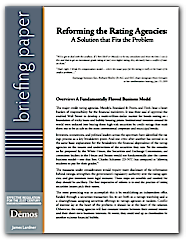Any such reform is, of course, bound to be strenuously opposed by the current top managers and major shareholders of the rating agencies. In recent years, these companies have reached fabulous new heights of profitability by dispensing something precious—an investment-grade rating—without a sense of duty to properly investigate, or even fully understand, the securities they were rating. (Moody’s, whose profits quadrupled between 2000 and 2007, had during five of those years the highest profit margins of any company in the S&P 500.23) At the rating agencies, as at the big banks, insiders are working hard to preserve a business model that has been good for them, and bad for everybody else. That is something that our elected leaders should be working just as hard to prevent.
-
Senate Committee on Banking, Housing and Urban Affairs, confirmation hearing for Mary Schapiro as Chair of the Securities and Exchange Commission, Jan. 15, 2008.
-
Frank Partnoy,“Rethinking Regulation of Credit Rating Agencies: An Institutional Investor Perspective,” Council of Institutional Investors, July 2009; Lawrence J. White, statement for the “Roundtable to Examine Oversight of Credit Rating Agencies,” U.S. Securities and Exchange Commission, April 15, 2009.
-
Roger Lowenstein, “The Ratings Game,” New York Times Magazine, April 27, 2008.
-
James Lardner, Beyond the Mortgage Meltdown: Addressing the Current Crisis, Avoiding a Future Catastrophe, Dēmos, June 2008.
-
Elliot Blair Smith,“Bringing Down Wall Street as Ratings Let Loose Subprime Scourge,” Bloomberg, Sep. 28, 2008.
-
Roger Lowenstein, “The Ratings Game,” New York Times Magazine, April 27, 2008; Moody’s Investor Service, “Subprime
Residential Mortgage Securitizations: Frequently Asked Questions,” April 19, 2007.
-
Roger Lowenstein, “The Ratings Game,” New York Times Magazine, April 27, 2008; Moody’s Investor Service, “Subprime
Residential Mortgage Securitizations: Frequently Asked Questions,” April 19, 2007.
-
Testimony of Deven Sharma, Raymond McDaniel, and Stephen Joynt before the President of Standard & Poors, before the
House Committee on Oversight and Government Reform, Oct. 22, 2008.
-
Elliot Blair Smith,“Bringing Down Wall Street as Ratings Let Loose Subprime Scourge,” Bloomberg, Sep. 28, 2008.
-
Opening Statement of Rep. Henry Waxman, Chairman, Committee on Oversight and Government Reform, U.S. House of
Representatives, Oct. 22, 2008.
-
“Credit and Credibility,” PBS Now, Week of Dec. 26, 2008.
-
Gretchen Morgenson,“Debt Watchdogs: Tamed or Caught Napping?,” The New York Times, Dec. 6, 2008.
-
Elliot Blair Smith,“’Race to Bottom’ at Moody’s, S&P Secured Subprime’s Boom, Bust,” Bloomberg News, Sep. 25, 2008.
-
Elliot Blair Smith,“’Race to Bottom’ at Moody’s, S&P Secured Subprime’s Boom, Bust,” Bloomberg News, Sep. 25, 2008.
-
Jerome Fons, Testimony before House Committee on Oversight and Government Reform, Oct. 22, 2008.
-
Kevin G. Hall,“How Moody’s Sold Its Ratings—and Sold Out Investors,” McClatchy Newspapers, Oct. 18, 2009.
-
Henry Waxman, opening statement, hearing of the House Committee on Oversight and Government Reform, Oct. 22, 2008.
-
David Raboy, “Concept Paper on Credit Rating Agency Incentives,” Congressional Oversight Panel, Jan. 9, 2009.
-
Jerome Fons,“White Paper on Rating Competition and Structured Finance,” Gerson Lehman Group, April 10, 2008.
-
David Segal, “Ohio Sues Rating Firms for Losses in Funds,” The New York Times, Nov. 20, 2009.
-
Lorraine Woellert and Dawn Kopecki, “Credit-Rating Companies ‘Sold Soul,’ Employees Said,” Bloomberg News, Oct. 22, 2008.
-
House Financial Services Committee, markup session, Oct. 27, 2009. Video available at http://financialserv.edgeboss.net/
wmedia/financialserv/markup102709.wvx.
-
Henry Waxman, opening statement, hearing of the House Committee on Oversight and Government Reform, Oct. 22, 2008.

